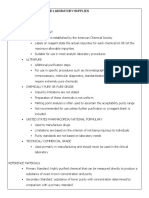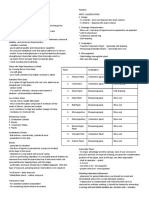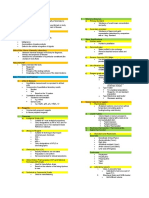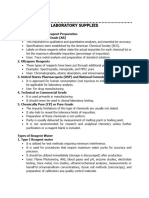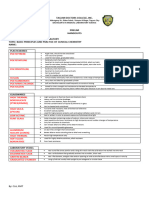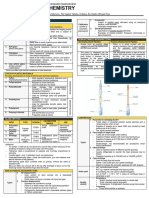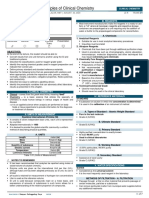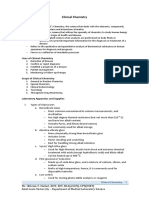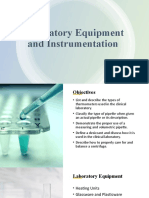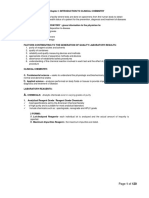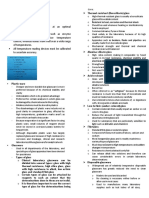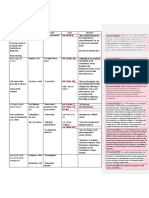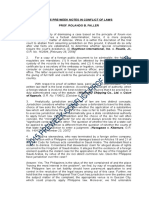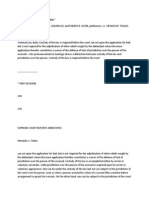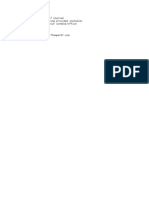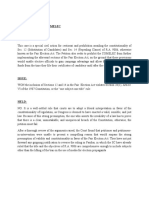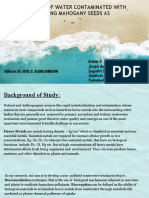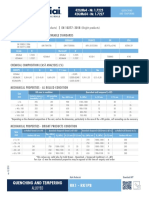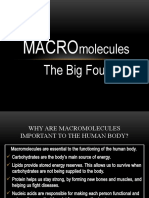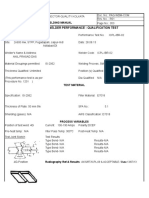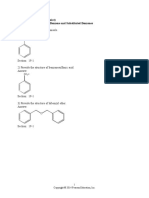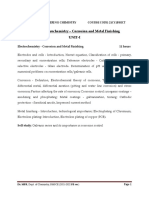CLINICAL CHEMISTRY: BASIC PRINCIPLES & PRACTICE - Calibrated for volume it delivers (more accurate)
2. Drainage
Clinical Laboratory Supplies Self-draining
1. Thermometer (units, types) - Contents drain via gravity
Thermistor – electronic Blow-out
Liquid-in-glass – alcohol with dye - Makes use of an aspirator bulb to blow out
2. Glassware contents
Should be Class A - Has mark near mouth piece (top) of an etched ring
Borosilicate / double ring / frosted band
- Brands: Pyrex, Kimax Types of Pipettes
- Incorporated with Boron Oxide 1. Measuring / Graduated
- Free from magnesia-lime-zinc group of elements Dispenses several different volumes
(contaminants) With many calibration / graduation lines
- High thermal resistance glassware 510 C Measures several fractional volumes as long as
- Temperature transitioning should be slow calibrations suffice
- Not chemically strong (can’t handle very acidic / Mohr (with residual liquid)
alkaline solutions) - TD, self-draining, calibrated between two marks
Aluminosilicate Serologic (full pipette)
- Acid and alkaline resistant - TD, blow-out, calibrated down to the tip (end)
- High thermal resistance 2. Transfer
- Chemically strengthened Measure only one volume
- Brands: Corex (TR: 672 C), Vycor (TR: 900-1200 C) Has a bulb on the stem
High Silica Volumetric
- Same thermal resistance as Vycor - Bulb in the middle, TD, self-draining, for aqueous
- Optically pure (clear glass) solutions
Low Actinic Ostwald Folin
- Glass w/ color (red or amber) - Bulb on lower part of stem, TC/TD, blow-out, for
- For vitamins, metabolites, bilirubin, and other viscous solutions
photosensitive substances 3. Pasteur
Flint Droppers
- Soda-lime glass 4. Automatic
- Thinnest material and least expensive Air Displacement
- For making disposable glassware (droppers) - Principle of operation: air displacement
3. Plasticware - Air is aspirated and pushed out
Flexibility, resistance to corrosion & breakage - Has disposable delivery tip per solution to avoid
Can’t withstand high temperature contamination
Polysterene, polyethylene, polypropylene, tygon, Positive Displacement
Teflon, polycarbonate, PVC - Very much like needles
Teflon - Found on machines
- Polycarbon - Machine washes itself every time tests are run,
- TR: 255 C thus washes the pipettes as well
- Used for extremes of temperature Dispenser or Diluter / Dispenser
- Can be frozen to temperatures as low as -270C - Has a container for dilution + capillary pipette
Cleaning 5. Micropipette
- General use: soapy water, acid dichromate Small capacity
mixture Transfer of 1ml or less
- Blood clots: 10% NaOH 1 ml = 1000 µm
- New pipettes: 5% HCL; 5%HNO3 Ex: RBC and WBC pipettes (graduated)
- Metal ion determinations: 20% HNO3; 1:2 HNO3;
1:2 HCl Reagents
- Grease: Organic solvent; KOH & Ethanol solution; 1. Chemicals
Contrad 70 Analytical procedures are prone to contaminations
- Bacteriologic: 2-4% ethanol Grades: Analytical Reagent Grade, Ultrapure, Chemically
- Permanganate stains: 50% HCl; 1% Ferrous Pure, United States Pharmacopoeia, National Formulary,
Sulfate in 25% H2SO4 technical / commercial
4. Laboratory Vessels Analytical Reagent Grade
Flasks, beakers, graduated cylinders - Certified by the American Chemical Society
5. Pipettes (checks purity of chemicals)
Transfer of liquids; glass or plastic; TC or TD; may or may Ultrapure
not be blown out; may or may not be rinsed - Higher purity than ARG
6. Burettes - For special procedures: chromatographic grades
7. Balances Chemically Pure
8. Desiccators / Desiccants - Not appropriate for analytical use
- Not certified (self-certification)
Classifications of Pipettes - Purity is checked by boiling / melting point analysis
1. Calibration / design - Variable checking of purity
TC (to contain) or rinse-out United States Pharmacopoeia and National Formulary
- Calibrated for the volume it contains - Safety for human consumption (manufacturing of
- Residual liquid changes final volumes when drugs)
transferred
Technical / Commercial
- Rinsing technique: to increase accuracy
- Least purity
TD (to deliver) - Not used for analytical procedures
� - Available commercially
2. Reference Materials Basic Separation Techniques
Aka “standards” (have known conc.) 1. Extraction
All lab tests are based on standards (calibrations) Done in research labs (not clinical)
Primary Standards Uses immiscible solvents to extract
- Highest purity level 2. Lyophilization
- ACS certified (almost 100% purity) Freeze-drying
- Expensive Exposes solution/substance to sub-zero temp. to dehydrate
Secondary Standards and conserve
- Not as expensive Becomes powder in form which is reconstructed with a
- Values are based on primary standards solvent
Standard Reference Materials / Certified Reference Ex: powdered milk
Materials 3. Dialysis
- Routinely used in the lab Uses dialyzing membrane to separate small particles from
- NIST (National Institute of Standards and bigger ones in a solution
Technology) certified 4. Filtration
5. Centrifugation
Water: most commonly used reagent in the laboratory (reagent grade water) Used in the clinical chemistry lab
For obtaining serum and plasma
Types of Water (based on purity level) Uses gravitational force to separate blood components based
1. Type 1 Water on density
- Most pure RCF = relative centrifugal force: 1.118 x 10-5 x r x rpm2
- Minimal contaminants Tachometer: inducts speed and force of centrifuge
- For preparing standards Rotor: spinning part with buckets / carriers
- Cannot be stored because of contamination Carriers: where test tubes are placed
possibilities
Standard: 10 minutes; 850-1000 x g
2. Type 2 Water
- Good for most lab procedures
Types of Centrifuge
- Storage: short duration only
1. Refrigerated or Unrefrigerated
3. Type 3 Water
2. Floor type: big
- Used for qualitative procedures
3. Bench type: small
- For glassware washing
4. SeroFuge: calibrated to use for serum
5. Ultra-Centrifuge: based on speed (faster)
Type 1 Type 2 Type 3 6. Swinging Bucket / Horizontal Head
Max. Colony Count <10 1000 NS (not - Movable, horizontally inclined, uniform sediment
-bacterial contam. specified) production
-colony forming units per mL 7. Fixed / Angle Head or Fixed Head
Silicate 0.05 0.1 1.0 - Angled carriers at 15-40°, non-movable, subjected
-glass particles (contamination) to more air friction, slanted
-mg/L
Resistivity 10 1.0 0.1
-inverse of conductivity to
electricity
-the purer the water, the less
conductive
-megOhms/cm
Ph NS NS 5-8
(neutral) (neutral)
Methods of Water Purification
1. Distillation
- Oldest method
- Vaporization & condensation
- Removal of organic contaminants
2. Deionization
- Removal of ion impurities
- Principle involved: ion exchange via resins
- Anion Exchange Resins: remove anionic
impurities in exchange for OH ions
- Cation Exchange Resins: remove cationic
impurities in exchange for H ions
- Mixed Bed Resins: both anionic and cationic
exchange
3. Reverse Osmosis
- Water forced to pass through semi-permeable
membrane
4. Filtration
- Submicron filtration
- Filter pore size: <0.22 µm
5. UV Light and Ozone Treatment
- Removal of microorganisms
6. Sterilization: autoclave

